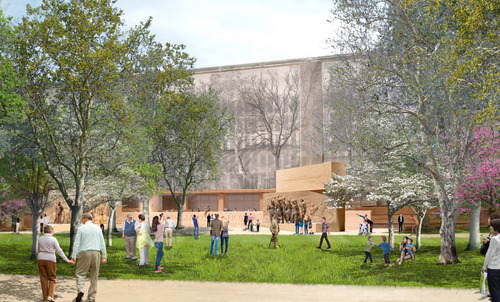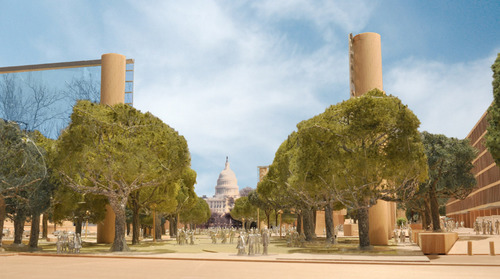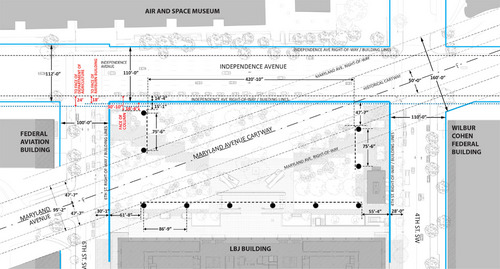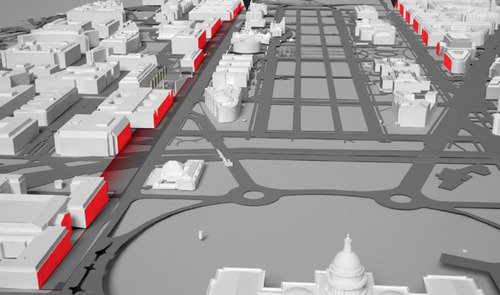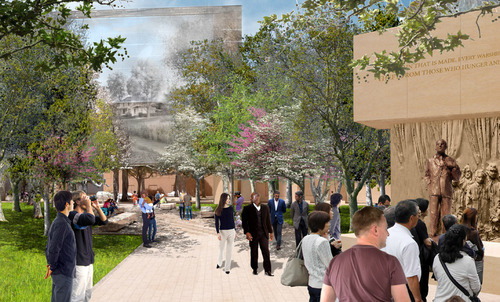The Eisenhower Memorial is moving forward, but metal tapestries might get in the way of the view
A proposed memorial to President Eisenhower in Southwest DC keeps trudging through the federal approvals process, even as it’s surrounded by controversy. But federal planners want some changes, especially to the way the memorial affects views of the Capitol.
The National Capital Planning Commission (NCPC) will review the project at its meeting Thursday. NCPC doesn’t decide whether the memorial is aesthetically good enough; that job lies with the Commission on Fine Arts. But it will consider whether the design meets various technical requirements, complies with federal laws on memorials, and most of all how it fits into the commission’s interpretation of the L’Enfant Plan.
The NCPC staff recommendation carries a lot of weight with the commission board, which will make the decision. The big news in the report was that repeated tests found that the 80-foot-tall stainless steel tapestries, which are a major (and very controversial) part of the design, dramatically exceeded durability requirements.
The National Park Service also found that the memorial’s maintenance costs would be about the same as those of the Martin Luther King, Jr. Memorial, and less than half of the World War II Memorial’s.
The report says that the current design meets 4 of the 7 principles NCPC set down for the memorial in 2006: It creates a green space, respects the surrounding architecture, helps to restore Maryland Avenue, and creates a unique commemorative space.
However, the staff had some objections about how the tapestries affect the monumental openness the NCPC sees in the L’Enfant Plan. Other concerns revolved around lighting and pedestrian circulation.
The design of the memorial has changed considerably over the past four years. Critics have portrayed Frank Gehry’s attitude as inflexible, but the NCPC submission package shows a dizzying number of alternatives and tweaks. Documents given to the CFA show even more.
In the wake of a bitter conflict with President Eisenhower’s grandchildren, Gehry added larger-than-life statues in front of the bas reliefs, adjacent to a life-size statue of teenaged Eisenhower. These changes rightly put more emphasis on Eisenhower’s accomplishments.
Officials wanted to be sure the tapestries would survive exposure to the elements over a long period of time. Independent studies tested tapestry elements’ resistance to corrosion, impact, and fatigue. The corrosion tests subjected the tapestry to water, salt, soot, and sulfur dioxide, simulating acidic pollution that causes damage to the stone and bronze typical of DC’s monuments.
Using the stainless steel alloy that the fabricator has chosen, 317L, there was almost no corrosion, and welds held 5 times the expected load even after a thousand-hour salt water shower. The National Institutes of Standards and Technology, the Department of Defense, and the Smithsonian Institution concluded that the tests met their standards.
The Park Service also dismissed concerns from opponents that trash would accumulate; the largest concern seems to be that the designers did not pay enough attention to the effects of bird poop.
Viewsheds strike again
However sturdy, the tapestries infringe on the Maryland and Independence Avenue rights-of-way, the NCPC staff report argues, and diminish the significance of the surrounding buildings in making an urban space.
The report finds that the tapestries and columns change the view towards the Capitol significantly, specifically narrowing it from the full 160-foot right-of-way to a 95-foot gap. The Gehry team argues that the rules permit artworks like the tapestries to occupy the right-of-way, but not a 50’ gap at the center called the cartway. The designers say that the tapestries frame the view of the Capitol Dome, bringing more attention to it.
NCPC staff agree in principle, but say the 10’ diameter, 80’ tall columns and semi-opaque screens impact the view enough to violate this rule. Moreover, they say this approach contradicts L’Enfant’s vision for wide-open monumental avenues.
Similarly, the NCPC report found that one column along Independence Avenue extends past a 50-foot setback line matching the adjacent Wilbur Wright (FAA) and Wilbur Cohen (SSA) buildings. The design team argues that since setbacks on Independence Avenue range from 24’ to 133’, NCPC’s choice to use directly adjacent buildings is arbitrary.
Finally, the report finds that the way the tapestries create a semi-transparent precinct within the existing building fabric overshadows the existing buildings, particularly the LBJ Department of Education building. The bottom third of the tapestries would be almost solid, the middle section would be around half solid, and the top, around 20%. The report deems this level of density to be too high to respect the architecture of the building behind it.
I understand the concerns of the NCPC staff. The L’Enfant Plan is a landmark that deserves respect. However, compared to the rigor of the technical analysis, the justifications for the principles are a little thin.
Unoccupiable columns are not buildings. Semi-transparent screens are not simply walls. The reciprocal views aren’t ruined on Maryland Avenue. Screening a background isn’t the same as blacking it out. Using the unremarkable, objectlike Wilbur Wright Building to establish a 50’ setback needs more justification than what’s in the report, particularly since NCPC violated its own height rules to approve the MLK memorial.
Conceptually, treating the 160-foot corridor as the total viewshed turns it into a beautiful abstraction unmoored from the experience of people actually there. It defers too much to the beautiful emptiness that’s great for looking at but not so good for daily life.
There’s already a stately, monumental avenue across the Mall. The Eisenhower Memorial offers a future for Maryland Avenue that preserves the key view while putting pedestrians first.
The memorial’s most underappreciated aspect is the proposed LBJ Promenade, a street-sized walkway framed by the Education building and the tapestries. Meant to make more of pedestrian connection than is currently there, that kind of dense space is what a live-work Southwest needs. The NCPC may still find fault with the position of the tapestries, but I’d be more persuaded by their reasoning if they emphasized the tidiness and monumental emptiness less for this site.
The Eisenhower Memorial still has a long way to go before a shovel hits the ground. The agencies with power to approve or halt the memorial have very different opinions. The Commission of Fine Arts likes how the tapestries frame the view to the Capitol, but a few members question their ability to enclose the space. A Congressional committee has proposed stripping funding from the memorial for the year, but that might change if NCPC approves the design. There is a lot of uncertainty at this time.
At the same time, the team has met many of the objections from the Eisenhower grandchildren. The technical evaluations of the memorial have been promising. The doubt in my mind has been eroding. It’s too early to count the memorial out.

